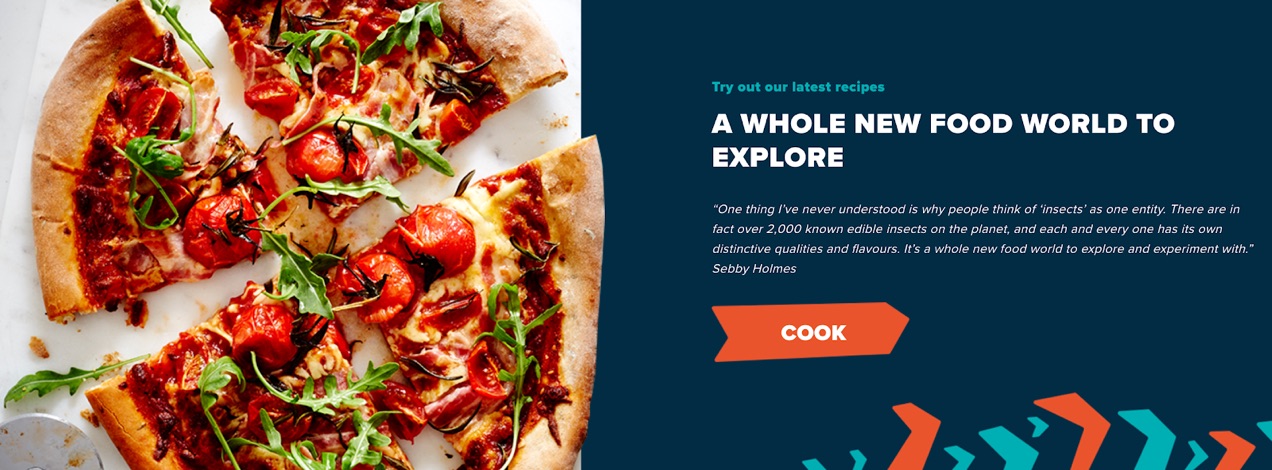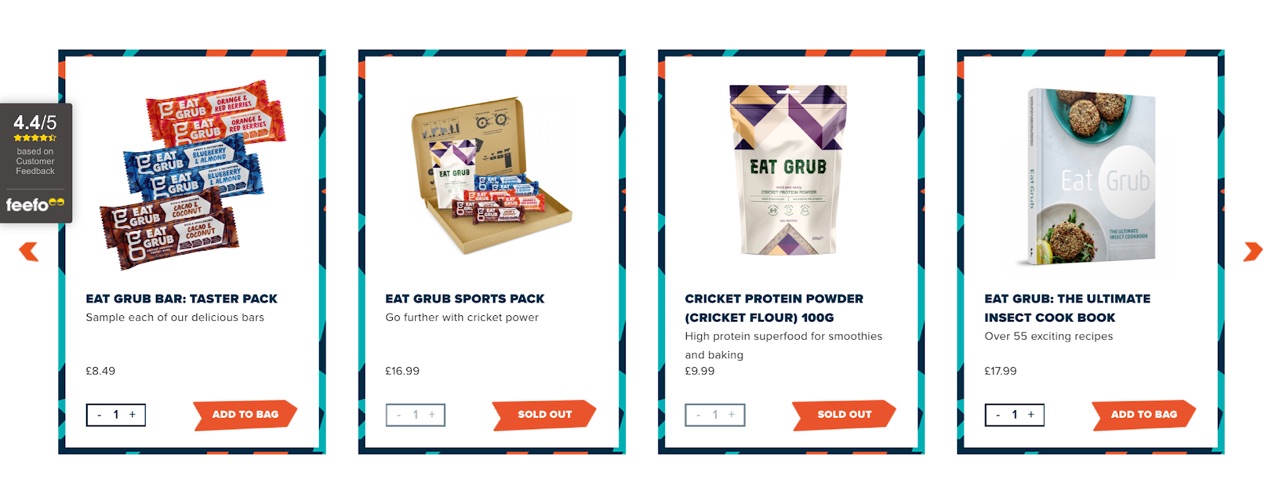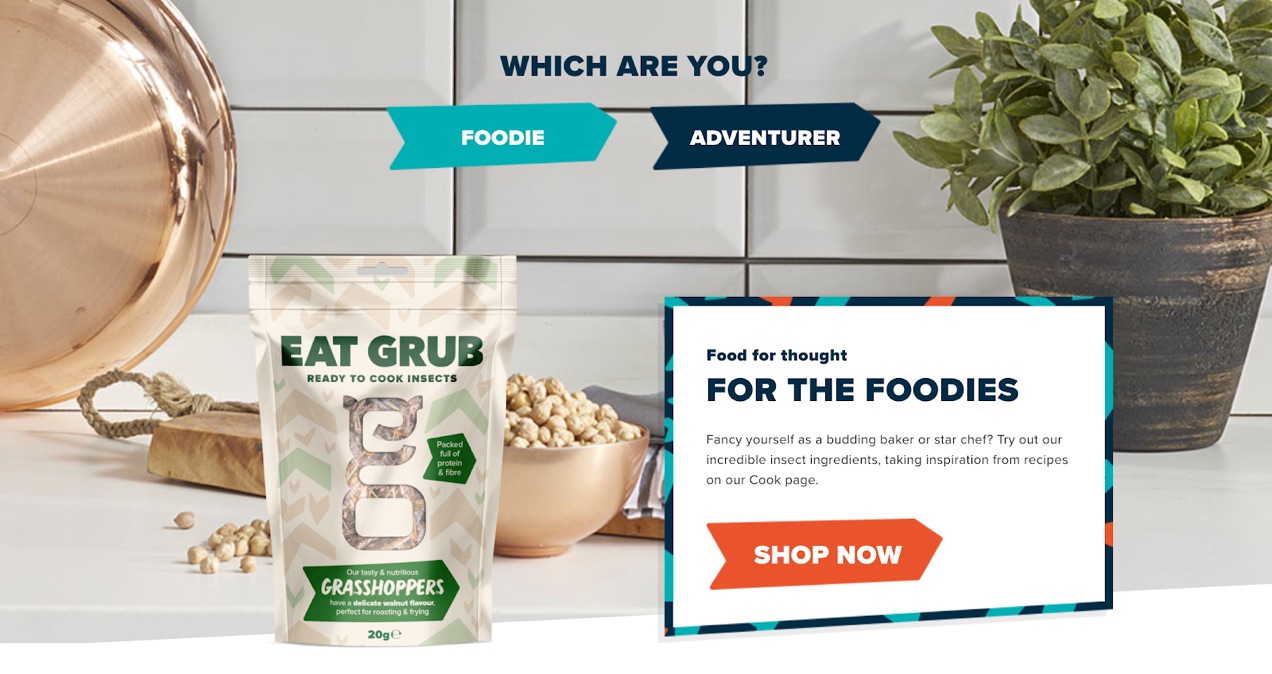Neil Whippey and Shami Radia, the founders of Eat Grub, are on a mission to “change the way the West eats”. With their successful eCommerce business, this London-based duo is promoting insects as a sustainable and nutritious source of food – one delicious snack at a time.
Hatching a Plan
A few years ago, Shami was working for a clean water charity that regularly sent him to developing countries. It was on a trip to Malawi that he witnessed locals collecting termites after a rainfall, frying them up in lime and chilli, and serving them as a tasty snack. “After doing a bit more research on nutrition and sustainability, it made a lot of sense,” he says. “Then it became a marketing challenge. How do we get people in the West to change their perception of eating insects?”

Shami discussed his idea with Neil, an old high school friend, who was already interested in nutrition for personal health reasons. Together with the help of rising culinary star Sebastian Holmes, they devised a plan to open an insect-themed pop-up restaurant in London in 2014. To their delight, the venture was a hit and gave them the encouragement they needed to turn it into a business.
Energized by their London success, Shami and Neil set off to develop the perfect product for their audience of insect-loving foodies. However, a bit of market research around early adopters, trendsetters, and innovators revealed a new opportunity: fitness and nutrition junkies. “We’ve entered the market at a perfect time with a growing awareness of nutrition and a real trend right now for a high-protein diet,” says Shami.

And insects genuinely are a superfood. They’re high in protein, iron, calcium, zinc, omega-3 and 6, amino acids, and B12. According to Shami, it’s the nutrition that gets people interested, not the sustainability, even though it’s a much more environmentally-friendly option than livestock farming. “We’re in this space where there is more awareness, and we’re targeting that group,” he says. “We’re not going mass market. We need to conserve our energy and be smart and selling online allows us to do that.”
The Business of Bugs
When Eat Grub first launched their online store, they chose WooCommerce because it was an affordable and accessible option for two budding entrepreneurs. Shami felt WordPress with WooCommerce was a straightforward platform for people like him who didn’t code but understood how everything fit together.
While he admits early versions of their website were done on a shoestring budget, years of good content and savvy SEO optimization laid a solid foundation for Eat Grub’s online presence. With such an unusual product, the messaging and content on their shop played a considerable role in increasing sales. With WordPress, it was easy to publish recipes and new blog posts educating customers on the world of cooking with bugs.
“We spent time deciding whether we wanted to use WooCommerce, Shopify, or design our bespoke website. In the end, given that we wanted to continue doing the blog and the recipes, we felt like WordPress and WooCommerce were still the best fit for us.”
After raising seed investment in 2017, they decided to redesign their site to bring the gastronomical and nutrition aspects of their business under one cohesive brand. Even with the opportunity for a fresh start, Neil and Shami decided to stay with WooCommerce. “We spent time deciding whether we wanted to use WooCommerce, Shopify, or design our bespoke website,” he says. “In the end, given that we wanted to continue doing the blog and the recipes, we felt like WordPress and WooCommerce were still the best fit for us.”

The new design focused on the customer journey and crafting a user experience that would lead to more conversions. Eat Grub sells the ingredients for cooking, salty snacks, energy bars, and taster packs, allowing customers to have more choice about how they enter the market. By letting people self-identify as a foodie or as an adventurer, the products are filtered for a smoother shopping experience.

This new approach has also informed their digital marketing strategy. By using lookalike audiences on Facebook, Shami and Neil are growing their customer base and are excited to try more display ads and pay-per-click advertisement. However, organic traffic still accounts for the bulk of their online traffic thanks to their cookbook and blog. Because of the healthy traffic that comes to their site, creating a beautiful and conversion-optimized WooCommerce shop is the focus of their online business.
The Eat Grub website uses many popular WooCommerce extensions and WordPress plugins to increase sales. They use bulk discounts, abandoned cart re-engagement emails with offers, and WordPress optimization tools like Smush and Yoast SEO. Shami is also a big believer in the power of customer reviews. “We use Feefo ratings because reviews inspire confidence, especially with something like edible insects,” he says. “Next, we’re looking into subscriptions, and we know there is a WooCommerce extension that will help us do that.”
From Gateway Grub to Retail Presence
Through growing their business, Eat Grub has found a solid product-market fit. Their goods offer curious customers a gradual introduction to eating bugs from cricket protein – the so-called gateway grub, to cooking with dried worms. As their product evolved, their WooCommerce shop has become more sophisticated and allowed them to a/b test, keep track of results, analyze the data, and act quickly. “Testing is just made easier by WordPress and WooCommerce,” says Shami.
About



i just wanted to say that reading this has been inspirational. im trying to get my lighting store set up at the moment http://www.lightsoflichfield.co.uk and i just hope that my dedication will pay off like yours 😉
Thanks for this feedback, all the best with your site — it looks great 🙂
thank you, just need to make sure i’m being indexed by google, load 8 thousand products, and make sure to keep a close eye on everything related to seo work and to try and figure out a some different keywords for ceiling lights, it seems i’ve chosen one of the hardest industry’s to break into but i hope it’ll all be worth it in the end 😉
You have written a nice and thoughtful article.
Wow, that’s really an amazing and inspiring story to read about entrepreneurs. Really, I am moved with their will to make things work out. I think the most important thing in an entrepreneur’s life is to stay calm and believe in his/her ambitions.
Regards
Thank you very much for publishing this kind of article. I like your article
Trending
A beginner’s guide to ecommerce SEO
By Kevin Bates •
How Landyachtz cut ecommerce costs by more than 75% and gained full control with WooCommerce
By Mahrie Boyle •
Prepare your business for 2026 EU tax changes
By Lynn J •
Never miss a beat — join our mailing list
Please enter a valid email.
View our privacy policy. You can unsubscribe anytime.
There was an error subscribing; please try again later.
Thanks for subscribing!
Emails will be sent to
You're already subscribed!
Emails are sent to